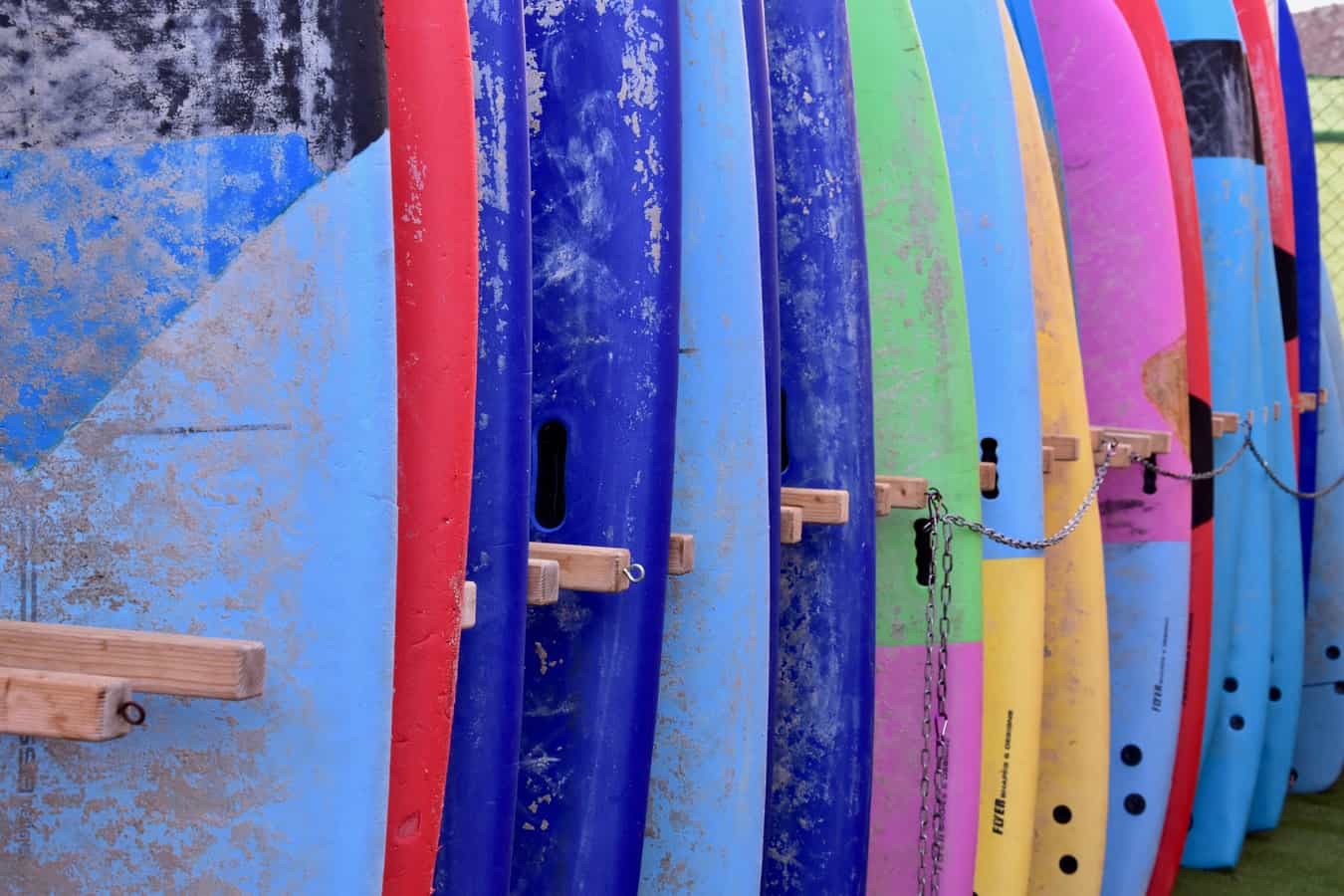Waxing your board is part of surfing. Without it we wouldn’t be able to stick when out in the water.
Early surfers, during the pioneer stage of surfing used floor waxes and candles to give their boards some traction. These days it’s much easier to work with and does its job much better than the originals.
Wax care is important though in taking care of your board and making sure you have the best sessions possible. But what is good care when it comes to wax, and is it ok to leave it on? It’s totally fine to leave wax on your surfboard, but it can stay on your board for weeks, depending on the amount of use. Not only is it ok to leave wax on your surfboard, but it’s the norm. Imagine the hassle of cleaning and reapplying a full wax every time you surfed? You’d spend more time on that than actually in the waves.
Wax doesn’t harm your surfboard, so it’s fine for it to stay for a long time. However, that doesn’t mean you should leave the same wax job on forever.
When surfing regularly, the wax on your board will get dirty, lose traction and get too thick in areas.
You stand on your board in the ocean so not only do your feet constantly rub it, but sand gets mixed in and stuck in the wax.
After consistent use, the wax on your board basically wears out, and instead of being super sticky and holding you to your board, it gets more slick.
You also probably add some wax when you go out to surf. This is necessary where the wax has melted off your board, but it also builds up and gets too thick in other places.
So to keep these from happening and to ensure your gear is up to par, you should fully clean and reapply wax every so often, like every couple months.
What Is Surf Wax?
Surfing wax is a hard wax generally made of paraffin, beeswax and petroleum jelly or oil to make it a little softer. It’s rubbed onto a surfboard to make it sticky, giving traction for riders.
Its use began back in the early twentieth century, using floor waxes, candles and other wax products. These did the job, but were hard to apply and sometimes bad for your board or body.
By the 60s surf wax made the addition of beeswax and oils to their formulas, which led to softer waxes that were easier to apply and created the little bumps that produce the best grip.
Today surf wax is still made with paraffin, beeswax and oils or petroleum jelly, but there is an array of vegan and eco friendly products as well.
The Types of Surf Wax
The surf wax we use today comes in different versions for various water temperatures. These are either softer or harder depending on the kind of water you’ll be surfing in.
Too soft and it will melt right off your board. Too hard and there will be no friction meaning you’ll slip right off.
Each type of surf wax has a temperature range it works best in, from frigid Northern European waters to seriously warm tropical seas.
Here’s a breakdown of each type and their temperature range in Farenheit.
Basecoat (no temperature)
Basecoat wax doesn’t have a temperature range because it’s used on all boards. Basecoat is a very hard wax that is applied before your regular wax.
It provides no traction but instead is used to help the surf wax stick to your board. It’s an important first step when it comes to waxing your board.
Cold Water (60 degrees and Below)
Cold water wax is the softest version. This wax needs to be softer because the super cold water hardens it up.
If you used too hard a wax for this temperature water, it would crack and be slick with no grip. A softer wax allows for traction in very cold water.
Cool Water (58 – 68 degrees)
The next step up from cold water wax. This is good for chilly waters like winter surfing in southern California. However it starts to melt in warmer waters.
Warm Water (66 – 78 degrees)
This wax will be harder with a higher melting point than the previous waxes. This is because the warmth of the water will soften the wax enough to provide grip and traction.
Tropical Water (75 degrees and Above)
Tropical water wax is the hardest of the waxes as it’s meant for seriously warm waters. This is for places like Costa Rica and Hawaii in the summertime.
The only wax (besides straight basecoat) that will be able to stand up to these kinds of oceans.

Removal and Application of Surf Wax
Depending on how often you surf, you should be stripping and applying a fresh coat of wax every eight to twelve weeks, or between four and six times a year.
The frequent reapplication of wax before surfing, the sand and dirt that sticks in the wax, all need to be cleared every so often. This helps keep your board in tip top shape and ready for your next session.
Removal
The first step in cleaning your board is removing the wax already there.
Use the scraper on the back of your wax comb or a similar flat edged plastic tool. Make sure it isn’t something sharp or otherwise made of a material that could damage or scratch your board like metal.
Use this flat edge to scrape away the bulk of your wax. You can lay your board in the sun to soften it up first or heat it up with a hairdryer, or you can go straight in.
Once you’ve scraped away the wax build up, you’ll still have a residue on your board. Use a warm washcloth or an oil, like coconut oil, to rub off this residue.
There’s also specific surf wax removers you can use, but stay away from any solvents that can harm the coating or paint job of your board.
Once all the wax is fully removed, your board is ready to be put away or for your fresh wax application.
Application
With a freshly cleaned board, you’re ready to start a new wax job.
Find a soft, or raised place to work on waxing that won’t cause harm to your board while you’re applying pressure, like across a couple stools padded with towels.
Start with the basecoat. Basecoat provides no grip for your feet, but it does provide a canvas for the wax applied over it to stick to. Hold the wax slightly angled to the board and use the edge to rub on the wax.
You’re looking for a smooth thin application anywhere your regular wax is going.
The general rule of thumb as to where you should wax, is anywhere your feet will be going. This usually translates to the middle of the board moving slightly forward to the nose, and back into the tail.
You usually don’t need to wax the nose of your board, but it’s common for longboarders to do so.
Go for more coverage over less, especially if you don’t pop up in the same place every time. Wax out close to the rails for grip when diving, but stay off the sides and underneath of your board, it’s unnecessary.
Once you have a thin layer of basecoat down, start rubbing in circles or a crosshatch formation until you see little bumps forming. These bumps are what your regular wax will stick to and how it will provide grip.
After your basecoat is done, grab your surf wax. You can apply in any formation you want to as long as you’re going evenly over your board.
You’re looking to form nice round bumps or beads across your board. If the beads start looking too oblong, switch direction and keep rubbing.
Remember, you’re building the stickiness onto your basecoat so be sure you’ve covered everywhere you’ve already waxed, and that you’ve used enough that your feet will grip easily.
Maintenance
Once you have your fresh wax job finished, your board is ready for storage or to be used right away but will require maintenance. Maintaining your wax job is fairly easy.
Give it a run through with the teeth side of your wax comb. This roughs up the wax you already have and helps make it stickier than when it’s pressed down flat from use.
After combing, you can rub another layer of your surf wax over the top for fresh grip.
You never need to reapply basecoat as it is already underneath the layers of wax you have. Doing so will provide no grip and be a waste of wax. Not to mention make it harder for your other wax to do its job.
Related Questions
How Much Does Surf Wax Cost?
Most surf waxes will run you a few dollars but can go up to nine or ten dollars.
Different brands range in different prices but generally you shouldn’t worry about spending much when it comes to wax.
People tend to have strong preferences on wax brands, but it’s a good idea to try out different ones to see what works for you. And since you’ll go through wax fairly quickly if you surf often, you’ll have plenty of chances to try.
How Long Does Wax Last?
Surf wax doesn’t have an expiration date, so it never goes bad. As far as how long wax will last on your board all depends on the water you’re surfing in and how often.
If you surf colder waters, your wax will probably last a fair amount of time since it never reaches its melting point. Whereas if you surf particularly warm waters, you may notice some has melted off, especially where you place your feet.
The same goes for where you put your board. If it’s hanging out in the sun, your wax will likely melt off versus leaving it in the shade.
How Often Should You Clean Your Board?
As a rough estimate you should clean and re-wax your board four to six times a year. This is really a minimum as you can clean and wax your board as often as you want.
Some surfers fully re-wax their board every month, while some let it go for a long time. In general though, if you only surf a couple times a month, you don’t have to clean your board very often.
If you surf everyday, your wax is getting dirty and building up more quickly and will require more frequent cleanings.

